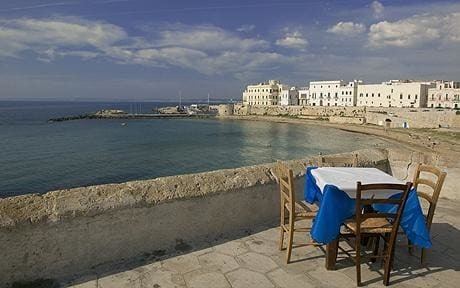Country Italy Demonym(s) Gallipolini | Elevation 12 m (39 ft) | |
 | ||
Frazioni Baia Verde, Lido Conchiglie, Lido San Giovanni, Rivabella, Torre del Pizzo Weather 11°C, Wind N at 21 km/h, 79% Humidity Patron saints Saint Sebastian, Agatha of Sicily, Christina of Bolsena Points of interest Samsara Beach, Lido Punta della Suina, Splash Parco Acquatico, Castle of Gallipoli, Torre Sabea | ||
Gallipoli (Greek: Kallipolis (Καλλίπολις), meaning "Beautiful City"; Sicilian: Caḍḍìpuli) is a southern Italian town and comune in the province of Lecce, in Apulia. In 2014, it had a population of 31,862.
Contents
- Map of Gallipoli Province of Lecce Italy
- Geography
- History
- Main sights
- Transportation
- Economy
- Sport
- International relations
- References
Map of Gallipoli, Province of Lecce, Italy
Geography
The town is located by the Ionian Sea, on the west coast of the Salentina Peninsula. The town of Gallipoli is divided into two parts, the modern and the old city. The new town includes all the newest buildings including a skyscraper. The old town is located on a limestone island, linked to the mainland by a bridge built in the 16th century.
The municipality borders with Alezio, Galatone, Matino, Sannicola and Taviano. It counts the hamlets (frazioni) of Baia Verde, Lido Conchiglie, Lido San Giovanni, Rivabella and Torre del Pizzo.
History
According to a legend, the city was founded in ancient times by Idomeneus of Crete. Pliny the Elder attributes the foundation to the Senones Gauls, while more likely it was a Messapic settlement. Historically, what is known is that Gallipoli was a city of the Greater Greece, ruling over a large territory including today's Porto Cesareo. In 265 BC it sided with Pyrrhus and Taranto against ancient Rome, suffering a defeat which relegated to a Roman colony (later a municipium).
In the early Middle Ages, it was most likely sacked by the Vandals and the Goths. Rebuilt by the Byzantines, Gallipoli lived an economically and socially flourishing period due to its geographical position. Later it was owned by the Roman Popes, and was a centre of fighting against the Greek monastic orders.
In the 11th century Gallipoli was conquered by the Normans and, in 1268, it was besieged by Charles I of Anjou, causing numerous inhabitants to flee to the nearby Alezio. The city was repopulated around 1300, under the feudal rule of the principality of Taranto. In 1484 the Venetians tried to occupy it, but without results. King Ferdinand I of the Two Sicilies started the construction of the port, which in the 18th century became the largest olive oil market in the Mediterranean.
After the unification of Italy (1861), Gallipoli was capital of a circondario, together with Lecce and Taranto.
Main sights
Transportation
Nearest airports are Brindisi, 88 kilometres (55 mi), and Bari, 200 kilometres (120 mi). Gallipoli can be reached from both of them via a modern freeway, the state road 101.
By train, it is connected to Lecce by the Ferrovie Sud-Est.
Economy
In past times the economy of Gallipoli was based on the international wine and oil commerce. Nowadays its most important activities are based on fishing and tourism.
Tourism is enjoyable throughout the year, due to the mild climate. Numerous are also the celebrations (civil and religious). These include the Carnival, Easter and all the parades, Sant'Agata, and the Santa Cristina celebrations in July.
Gallipoli also boasts a very recently built harbour for private boats, located just steps from the bottom of the main Corso Roma.
The summer season starts in May and ends in October, when the weather is almost invariably hot and clear.
Sport
The local football team is the Gallipoli Calcio. The team won the 2005–06 Serie C2/C championship. They have now been promoted to Serie B for the first time in the club's short history after winning the 2008–09 Serie C1/B championship.
International relations
Gallipoli is twinned with:
